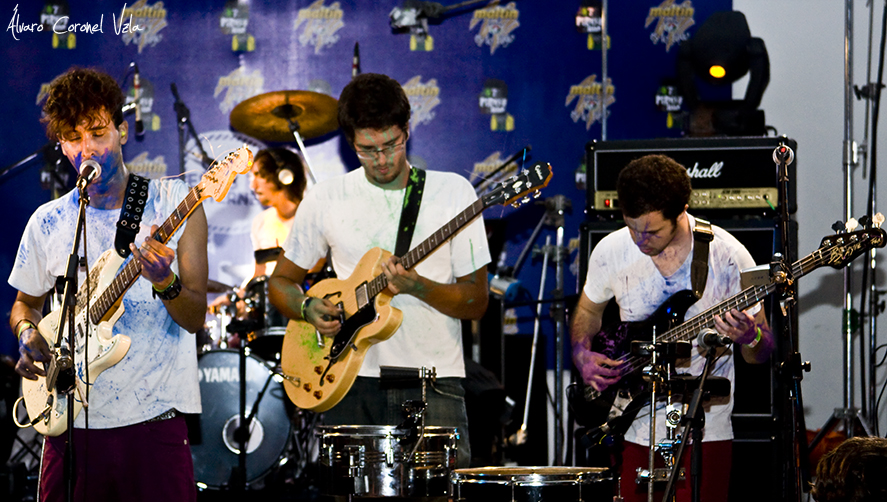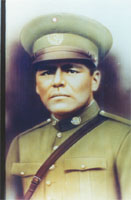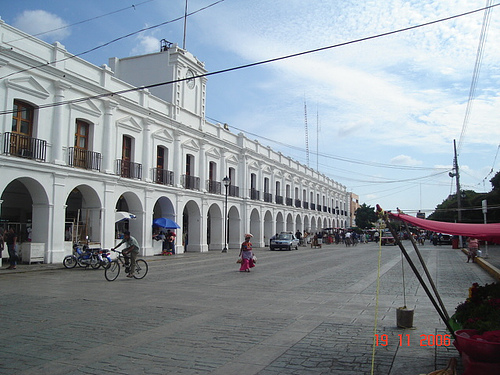|
Graciela Iturbide
Graciela Iturbide (born May 16, 1942) is a Mexican photographer. Her work has been exhibited internationally, and is included in many major museum collections such as the San Francisco Museum of Modern Art and The J. Paul Getty Museum. Biography Iturbide was born in Mexico City, Mexico in 1942, to traditional Catholic parents. The eldest of thirteen children, she attended Catholic school and was exposed to photography early on in life. Her father took pictures of her and her siblings, and she got her first camera when she was 11 years old. When she was a child, her father put all the photographs in a box; Iturbide later said: "it was a great treat to go to the box and look at these photos, these memories." She married the architect Manuel Rocha Díaz in 1962 and had three children over the next eight years: sons Manuel and Mauricio, and a daughter, Claudia, who died at the age of six in 1970. Manuel is now a composer and sound artist and has lectured at California College of ... [...More Info...] [...Related Items...] OR: [Wikipedia] [Google] [Baidu] |
Mexico City, Mexico
Mexico City ( es, link=no, Ciudad de México, ; abbr.: CDMX; Nahuatl: ''Altepetl Mexico'') is the capital and largest city of Mexico, and the most populous city in North America. One of the world's alpha cities, it is located in the Valley of Mexico within the high Mexican central plateau, at an altitude of . The city has 16 boroughs or ''demarcaciones territoriales'', which are in turn divided into neighborhoods or ''colonias''. The 2020 population for the city proper was 9,209,944, with a land area of . According to the most recent definition agreed upon by the federal and state governments, the population of Greater Mexico City is 21,804,515, which makes it the sixth-largest metropolitan area in the world, the second-largest urban agglomeration in the Western Hemisphere (behind São Paulo, Brazil), and the largest Spanish-speaking city (city proper) in the world. Greater Mexico City has a GDP of $411 billion in 2011, which makes it one of the most productive urban areas in ... [...More Info...] [...Related Items...] OR: [Wikipedia] [Google] [Baidu] |
Oaxaca City
Oaxaca de Juárez (), also Oaxaca City or simply Oaxaca (Valley Zapotec languages, Zapotec: ''Ndua''), is the capital and largest city of the eponymous Administrative divisions of Mexico, Mexican state Oaxaca. It is the municipal seat for the surrounding Municipality of Oaxaca. It is in the Centro District, Oaxaca, Centro District in the Valles Centrales de Oaxaca, Central Valleys region of the state, in the foothills of the Sierra Madre at the base of the Cerro del Fortín, extending to the banks of the Atoyac River (Oaxaca), Atoyac River. Heritage tourism makes up an important part of the city's economy, and it has numerous colonial-era structures as well as significant archeological sites and elements of the continuing native Zapotec civilization, Zapotec and Mixtec cultures. The city, together with the nearby archeological site of Monte Albán, was designated in 1987 as a UNESCO World Heritage Site. It is the site of the month-long cultural festival called the ''"Guelaguetza"'' ... [...More Info...] [...Related Items...] OR: [Wikipedia] [Google] [Baidu] |
Nuestra Señora De Las Iguanas By Graciela Iturbide
''Nuestra'' is the debut studio album of the Venezuelan rock band La Vida Bohème, released in August 2010. Recorded and produced by Rudy Pagliuca, it is a free download on the website of the record label All of the Above. The album was nominated for "Best Latin Pop, Rock or Urban Album" in the 54th Grammy Awards. The two singles from this album are "Radio Capital" and "Danz!". Background and Recording The album was recorded in Caracas in 2009, on fairly independent terms. Guitarist Daniel De Sousa happened to be studying engineering at the time, and took on designing a distortion pedal that was used on the album. The synths were designed/programmed by fellow Venezuelan artist Arca, then known as Nuuro. In popular culture The song "El Buen Salvaje" is included in the video game ''FIFA 12'', winning the MTV Game Awards 2012 for "Best song in a video game". "Radio Capital" is present in the Rockstar's video game ''Grand Theft Auto V ''Grand Theft Auto V'' is a 2013 ac ... [...More Info...] [...Related Items...] OR: [Wikipedia] [Google] [Baidu] |
Feminist
Feminism is a range of socio-political movements and ideologies that aim to define and establish the political, economic, personal, and social equality of the sexes. Feminism incorporates the position that society prioritizes the male point of view and that women are treated unjustly in these societies. Efforts to change this include fighting against gender stereotypes and improving educational, professional, and interpersonal opportunities and outcomes for women. Feminist movements have campaigned and continue to campaign for women's rights, including the right to vote, run for public office, work, earn equal pay, own property, receive education, enter contracts, have equal rights within marriage, and maternity leave. Feminists have also worked to ensure access to contraception, legal abortions, and social integration and to protect women and girls from rape, sexual harassment, and domestic violence. Changes in female dress standards and acceptable physical activiti ... [...More Info...] [...Related Items...] OR: [Wikipedia] [Google] [Baidu] |
Zapotec Languages
The Zapotec languages are a group of around 50 closely related indigenous languages of Mesoamerica, indigenous Mesoamerican languages that constitute a main branch of the Oto-Manguean languages, Oto-Manguean language family and which is spoken by the Zapotec people from the southwestern-central highlands of Mexico. A 2020 census reports nearly half a million speakers, with the majority inhabiting the state of Oaxaca. Zapotec-speaking communities are also found in the neighboring states of Puebla, Veracruz, and Guerrero. Human migration#Theories for migration for work in the 21st century, Labor migration has also brought a number of native Zapotec speakers to the United States, particularly in California and Bridgeton, New Jersey, New Jersey. Most Zapotec-speaking communities are highly bilingual in Spanish. Name The name of the language in Zapotec itself varies according to the geographical variant. In Juchitán (Isthmus) it is ''Diidxazá'' , in Mitla it is ''Didxsaj'' , in Zoog ... [...More Info...] [...Related Items...] OR: [Wikipedia] [Google] [Baidu] |
Zapotec Peoples
The Zapotecs ( Valley Zapotec: ''Bën za'') are an indigenous people of Mexico. The population is concentrated in the southern state of Oaxaca, but Zapotec communities also exist in neighboring states. The present-day population is estimated at approximately 400,000 to 650,000 persons, many of whom are monolingual in one of the native Zapotec languages and dialects. In pre-Columbian times, the Zapotec civilization was one of the highly developed cultures of Mesoamerica, which, among other things, included a system of writing. Many people of Zapotec ancestry have emigrated to the United States over several decades, and they maintain their own social organizations in the Los Angeles and Central Valley areas of California. There are four basic groups of Zapotecs: the ', who live in the southern Isthmus of Tehuantepec, the ', who live in the northern mountains of the Sierra Madre de Oaxaca, the southern Zapotecs, who live in the southern mountains of the Sierra Sur, and the Central Va ... [...More Info...] [...Related Items...] OR: [Wikipedia] [Google] [Baidu] |
Juchitán De Zaragoza
Juchitán de Zaragoza (; Spanish name; Isthmus Zapotec: ''Xabizende'' ) is an indigenous town in the southeast of the Mexican state of Oaxaca. It is part of the Juchitán District in the west of the Istmo de Tehuantepec region. With a 2005 census population of 74,714 inhabitants, it is the fourth-largest city in the state (just barely behind Salina Cruz). The majority of the indigenous inhabitants are Zapotec peoples, Zapotecs and Huave people, Huaves. The town also serves as the municipal seat for the surrounding municipality, with which it shares a name. The municipality has an area of 414.64 km² (160.1 sq mi) and a population of 85,869, the state's third-largest in population. It is located 26 km northeast of the city of Tehuantepec. Its Palacio Municipal dates back to the middle of the 19th century and perhaps is the widest "palace" in Mexico with 31 arches in its front portal. Its main church is the Parroquia de San Vicente Ferrer (Parish of San Vicente Ferrer) whi ... [...More Info...] [...Related Items...] OR: [Wikipedia] [Google] [Baidu] |
Francisco Toledo
Francisco Benjamín López Toledo (17 July 1940 – 5 September 2019) was a Mexican Zapotec painter, sculptor, and graphic artist. In a career that spanned seven decades, Toledo produced thousands of works of art and became widely regarded as one of Mexico's most important contemporary artists. An activist as well as an artist, he promoted the artistic culture and heritage of Oaxaca state. Toledo was considered part of the Breakaway Generation of Mexican art. Early life and education Toledo was born in Mexico City in 1940, the child of Francisco López Orozco and Florencia Toledo Nolasco. He studied at the Escuela de Bellas Artes de Oaxaca and the Centro Superior de Artes Applicadas del Instituto Nacional de Bellas Artes, Mexico, where he studied graphic arts with Guillermo Silva Santamaria. As a young man, Toledo studied art in Paris where he met Rufino Tamayo and Octavio Paz. Career Toledo worked in various media, including pottery, sculpture, weaving, graphic arts, ... [...More Info...] [...Related Items...] OR: [Wikipedia] [Google] [Baidu] |
Vietnow
"Vietnow" is a song by American rock band Rage Against the Machine and the final single from their album '' Evil Empire''. Officially it is only the third single from the album, as "Down Rodeo" was a promo release only. About The cover photograph of an elderly lady seen from the back, carrying a boombox radio and walking down a mountain was taken by the Mexican photographer Graciela Iturbide in the Sonoran Desert in 1979. The original photograph is called "Mujer Ángel" and has also appeared in the black-and-white photography book, ''Canto a la Realidad: Fotografia Latinoamericana, 1860-1993'' as compiled by Erika Billeter. The song's lyrics concern right-wing AM radio shows, hosted by people such as Rush Limbaugh, Oliver North and Michael Reagan. The verse riffs bear a resemblance to "The Wanton Song" by Led Zeppelin, whom Tom Morello has cited as a major influence. The lyrics "is all the world jails and churches" are perhaps influenced by the works of American novelist Jame ... [...More Info...] [...Related Items...] OR: [Wikipedia] [Google] [Baidu] |
Rage Against The Machine
Rage Against the Machine (often abbreviated as RATM or shortened to simply Rage) is an American rock band from Los Angeles, California. Formed in 1991, the group consists of vocalist Zack de la Rocha, bassist and backing vocalist Tim Commerford, guitarist Tom Morello, and drummer Brad Wilk. The band are known for their melding of heavy metal and rap music with punk rock and funk influences, and their revolutionary socialist political views. As of 2010, they have sold over 16 million records worldwide. The band was nominated for induction into the Rock & Roll Hall of Fame in their first year of eligibility in 2017, then again in 2018, 2019, and 2021, though the bids failed. Rage Against the Machine released its self-titled debut album in 1992 to commercial and critical success, leading to a slot in the 1993 Lollapalooza festival; in 2003, the album was ranked number 368 on '' Rolling Stone's'' list of the 500 greatest albums of all time. The band's next two albums, '' Evil ... [...More Info...] [...Related Items...] OR: [Wikipedia] [Google] [Baidu] |
TheGuardian
''The Guardian'' is a British daily newspaper. It was founded in 1821 as ''The Manchester Guardian'', and changed its name in 1959. Along with its sister papers ''The Observer'' and ''The Guardian Weekly'', ''The Guardian'' is part of the Guardian Media Group, owned by the Scott Trust Limited, Scott Trust. The trust was created in 1936 to "secure the financial and editorial independence of ''The Guardian'' in perpetuity and to safeguard the journalistic freedom and liberal values of ''The Guardian'' free from commercial or political interference". The trust was converted into a limited company in 2008, with a constitution written so as to maintain for ''The Guardian'' the same protections as were built into the structure of the Scott Trust by its creators. Profits are reinvested in journalism rather than distributed to owners or shareholders. It is considered a newspaper of record in the UK. The editor-in-chief Katharine Viner succeeded Alan Rusbridger in 2015. Since 2018, th ... [...More Info...] [...Related Items...] OR: [Wikipedia] [Google] [Baidu] |
Punta Chueca
Punta Chueca (Seri: ) is a Seri town located on the Gulf of California in the Mexican state of Sonora. It is located 25 kilometers north of the fishing and tourist town of Bahía de Kino. Both of these towns are part of the Municipality of Hermosillo. One of the two villages on the Seri Indian communal property (the other being El Desemboque (''Haxöl Iihom'')), it has small stores, a primary school and a small satellite-fed secondary school (''telesecundaria''). It is one of the closest points on the mainland to Tiburón Island, separated from it by the Canal del Infiernillo (''Xepe Coosot''). According to the Mexican census of 2010, the town (officially a locality, or ''localidad''), had a population of 520 inhabitants. Gallery Image:Punta Chueca Socaaix 1.JPG, ''Socaaix'' (Punta Chueca) with Tiburon Island in the background Image:GoritaPuntaChueca.JPG, "Corita" basket from Punta Chueca on display at the UABC cultural museum in Mexicali Mexicali (; ) is the capital city of ... [...More Info...] [...Related Items...] OR: [Wikipedia] [Google] [Baidu] |





.png)
